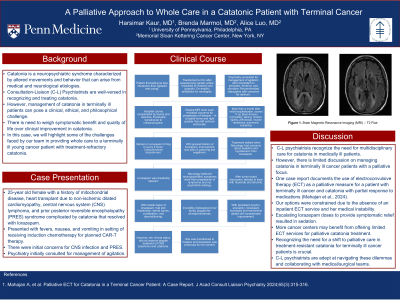Catatonia
(015) A Palliative Approach to Whole Care in a Catatonic Patient with Terminal Cancer


Harsimar Kaur, MD
Psychiatry Attending
University of Pennsylvania
Philadelphia, Pennsylvania
Harsimar Kaur, MD
Psychiatry Attending
University of Pennsylvania
Philadelphia, Pennsylvania- BM
Brenda Marmol, M.D.
Fellow
Memorial Sloan Kettering Cancer Center
Syosset, New York - BM
Brenda Marmol, M.D.
Fellow
Memorial Sloan Kettering Cancer Center
Syosset, New York 
Alice Luo, MD (she/her/hers)
Assistant Attending Psychiatrist
Memorial Sloan Kettering Cancer Center
New York, New York
Alice Luo, MD (she/her/hers)
Assistant Attending Psychiatrist
Memorial Sloan Kettering Cancer Center
New York, New York
Presenting Author(s)
Co-Author(s)
Introduction: Catatonia is a neuropsychiatric syndrome characterized by altered movements and behavior that can arise from medical and neurological etiologies. Although consultation-liaison (C-L) psychiatrists are well-versed in recognizing and treating catatonia, it can pose a clinical, ethical, and philosophical challenge when managing catatonia in terminally ill patients (i.e., weighing symptomatic benefit and quality of life over clinical improvement in catatonia). In this case, we will highlight some of the challenges faced by our team in providing whole care to a terminally ill young cancer patient with treatment-refractory catatonia.
Case: This is a 25-year-old female with a history of mitochondrial disease, heart transplant due to non-ischemic dilated cardiomyopathy, central nervous system (CNS) lymphoma, and prior posterior reversible encephalopathy syndrome complicated by catatonia that resolved with lorazepam. She was receiving induction chemotherapy before planned CAR-T therapy and presented with fever, nausea, and vomiting concerning for sepsis. Neurology and psychiatry were consulted for altered mental status and posturing. Lorazepam was initiated as she scored seventeen on the Bush-Francis Catatonia Scale. Improvement was seen in posturing and negativism with the titration of lorazepam. However, treatment stalled due to the primary team’s concerns about sedation with lorazepam. They opined that her neuropsychiatric symptoms were from the progression of CNS lymphoma and not from psychiatric cause, preferring treatment with chemotherapy and radiation. Lorazepam was tapered drastically, which led to worsening symptoms - skin breakdown requiring wound care, dental issues from teeth grinding, constipation, and deconditioning requiring physical/occupational therapy. This was incredibly distressing to her family despite her unresponsiveness. After persistent psychoeducation by our team, lorazepam was eventually increased, and memantine was added with symptomatic improvement. As her clinical status did not improve despite treatment of her CNS lymphoma and catatonia, she was transitioned to hospice. Lorazepam was continued as palliative care to alleviate distressing catatonic symptoms and to provide comfort to the patient and family.
Discussion: C-L psychiatrists acknowledge the necessity of multidisciplinary care for catatonia in medically ill patients. However, there is a scant discussion on managing catatonia in terminally ill cancer patients with a palliative focus. One case report documents the use of ECT as a palliative measure for a patient with terminally ill cancer and catatonia with partial response to medications (Mahajan, 2024). However, our options were constrained due to the absence of an inpatient ECT service and her medical instability. We considered increasing lorazepam for distressing posturing and immobility but concerns about excessive sedation and respiratory depression arose. More cancer centers may benefit from offering limited ECT services for palliative catatonia treatment. Recognizing the need for a shift to palliative care in treatment-resistant catatonia for terminally ill cancer patients is crucial. Despite the challenges of balancing clinical and ethical concerns, C-L psychiatrists are adept at navigating these dilemmas and collaborating with medical/surgical teams.
Mahajan A, et al. Palliative ECT for Catatonia in a Terminal Cancer Patient: A Case Report. J Acad Consult Liaison Psychiatry 2024. Epub ahead of print.
Presentation Eligibility: Not previously published or presented
Diversity, Equity, and Inclusion: This group includes women from a variety of career, age, and cultural backgrounds. This case highlights the importance of patient-centered care for individuals from marginalized groups facing terminal illness. By bringing together a multidisciplinary team to provide whole-person care for a young woman with multiple complicating medical conditions, including cancer, this case demonstrates an approach that values the patient's quality of life, and dignity. The ethical challenges of balancing symptomatic benefits with invasive treatments near end-of-life are relevant across diverse populations. Examining biases that may impact care for younger, terminally ill patients advances equity in palliative and end-of-life care delivery.

